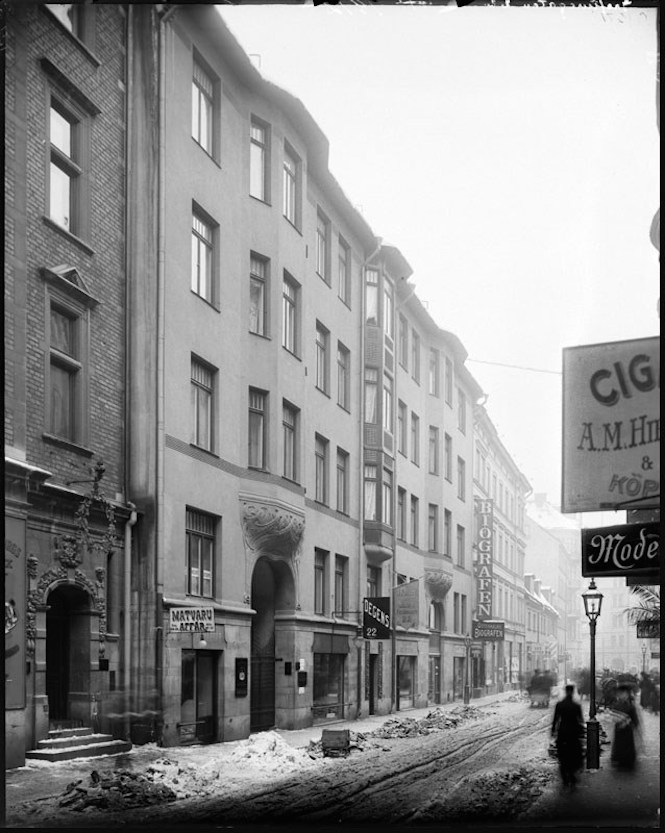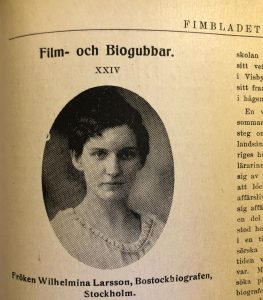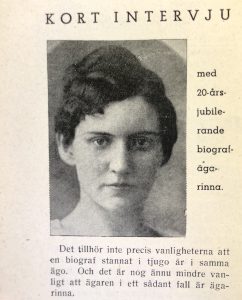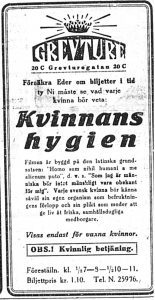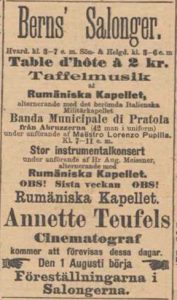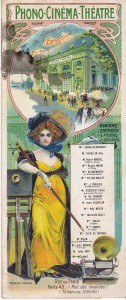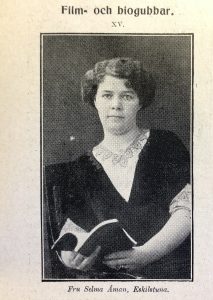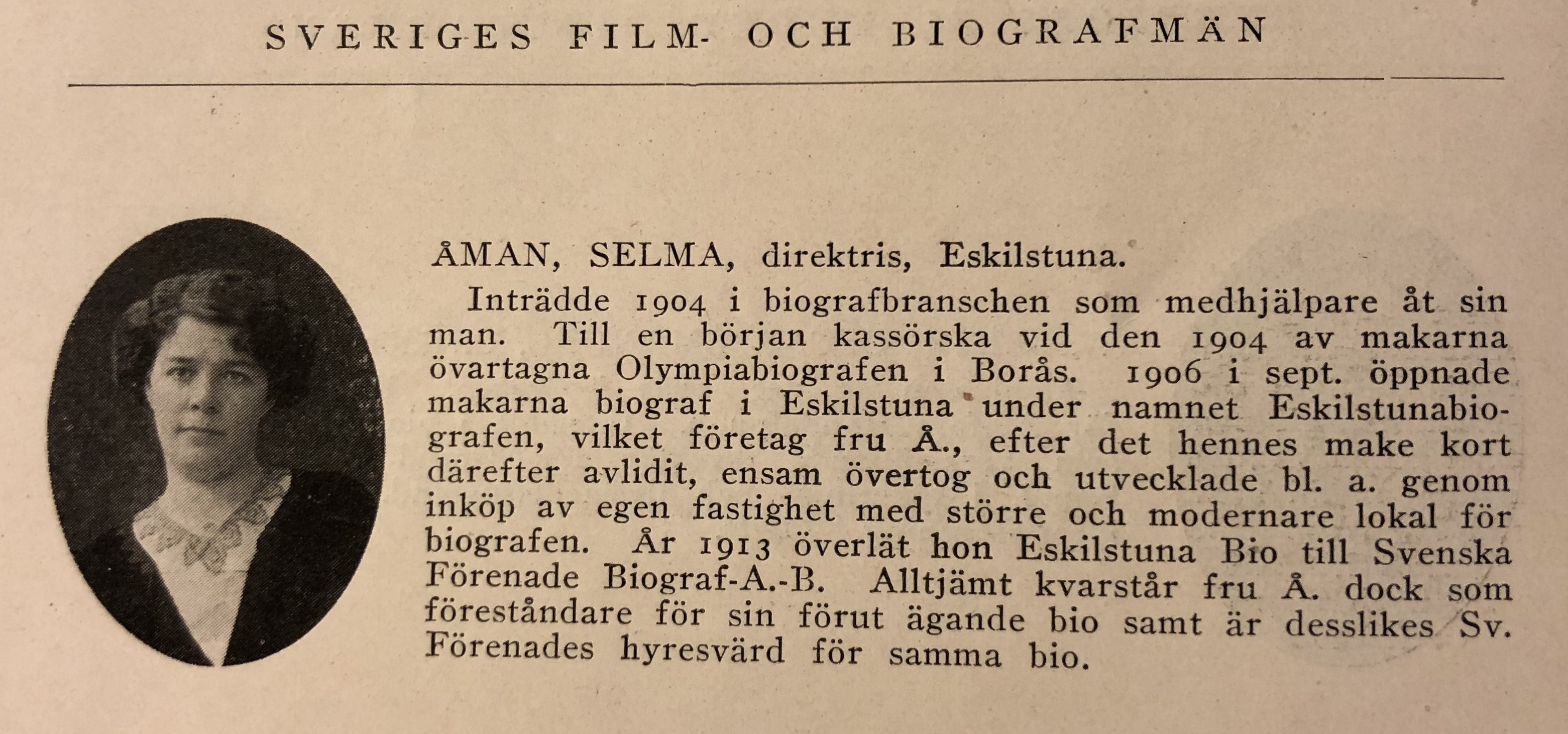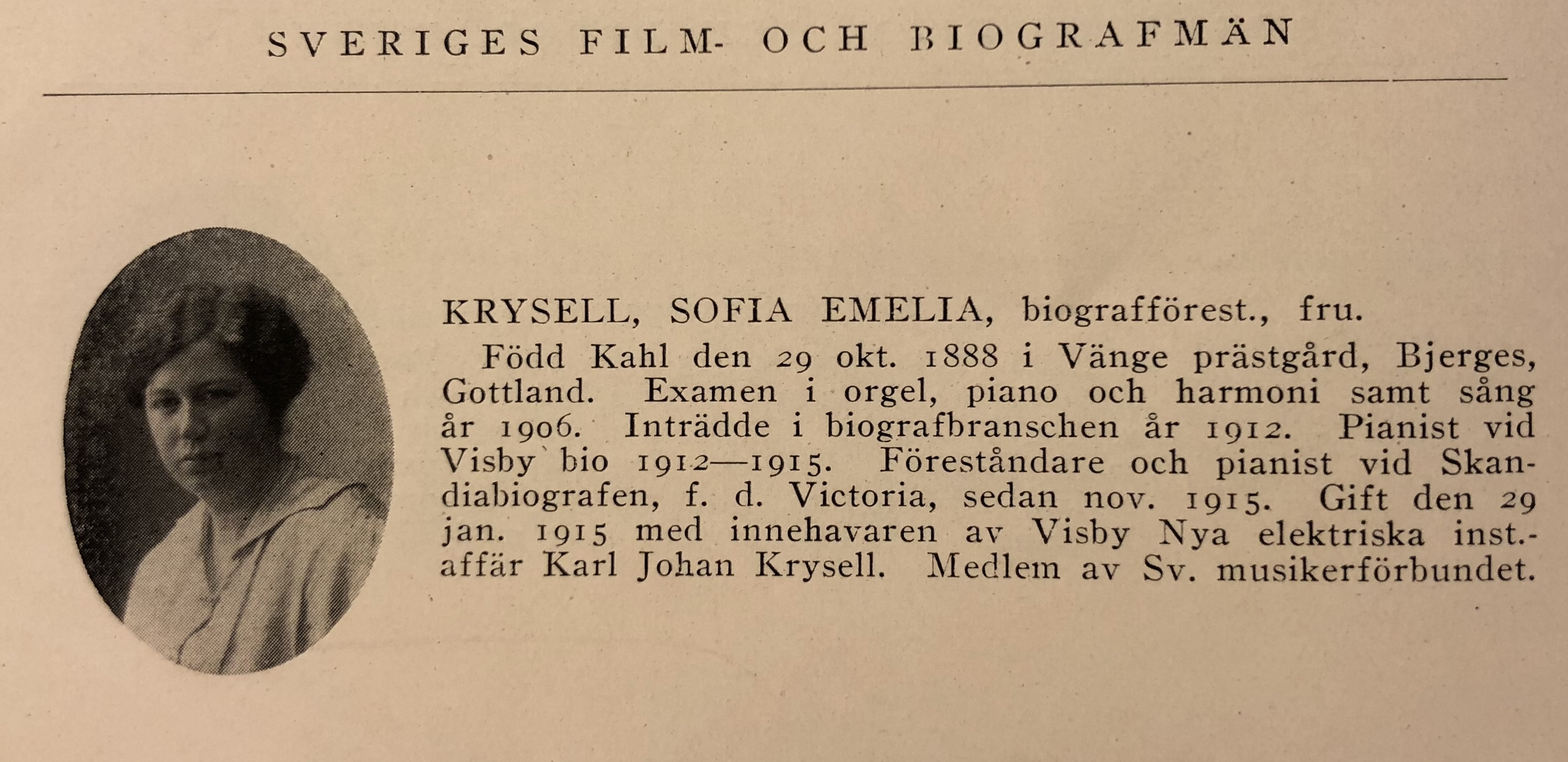Introduction
This essay investigates the role of women in Swedish film exhibition from the early days of ambulating film exhibitors, through the formation of a cinema culture with permanent venues, and all the way up to the coming of sound. Although membership and leadership of professional organizations, such as Sveriges Biografägareförbund/Sweden’s National Association of Cinema Owners (founded in 1915) or Svenska Film-och biografmannasällskapet/The Swedish Film and Cinema Society (founded in 1917), as well as contemporary articles in the trade press, reveal that cinema-owners and film exhibitors were male-dominated professions, a large number of women were nevertheless involved in running Swedish cinemas in the silent era. The title of the essay refers to the ways in which–as we shall see–women cinema managers have been described as respectable hostesses, turning their cinemas into tasteful, comfortable venues. However, “discrimination” can also refer to practices of unfair treatment, which have circumscribed women’s agency in different circumstances, and limited their presence in film history textbooks.
Background
In the Swedish census of 1910, two women described themselves as cinema-owners [biografägare].1Riksarkivet/The National Archives of Sweden’s digitized census records for 1910 are currently accessible only for on-site users at institutions that subscribe to the National Archives’ digital service “SVAR”. Unfortunately, the digitization of Swedish censuses does not yet include the census of 1920, and only parts of the census of 1930 have been digitized. When searchable records from 1920 and 1930 become available it should be easier to establish whether the percentage of women among cinema owners and managers in Sweden increased, remained stable, or decreased during the teens and twenties. At the time of the previous census in 1900, permanent venues for film exhibition had not yet been established, so the 1910 census was the first in Sweden to include the term that would become the established Swedish word for cinema theatres, biograf. The total number of self-described cinema-owners in this census was thirty-four. Considering that permanent venues for film exhibition had been established in both the Swedish capital of Stockholm and Gothenburg (Sweden’s second largest city) in 1904-1905, and continued to spread across the rest of the country from 1905 onwards,2Åsa Jernudd, “Spaces of Early Film Exhibition in Sweden 1897-1911,” in Cinema, Audiences and Modernity: New Perspectives on European Cinema History, eds. Daniel Biltereyst, Richard Maltby, and Phillipe Meers (London: Routledge, 2012), 23. and that there were twenty-five permanent cinema venues in Stockholm alone already by 1909,3Kurt Berglund, Stockholms alla biografer: Ett stycke Stockholmshistoria från 90-tal till 90-tal (Stockholm: Svenska Turistföreningen, 1992), 38. clearly not all Swedish inhabitants who owned and/or managed cinemas had their occupation labeled as such in the census of 1910.4Cinema-owners whose educational background or managerial status allowed this probably used other titles like “director,” “engineer,” or “architect” rather than “cinema-owner,” which in 1910 had a lower status than these more established titles. Among those who did, however, women represented almost six per cent, a figure that can be compared to Kathryn Fuller-Seeley and Karen Ward Mahar’s estimate that women accounted for two to five per cent of American nickelodeon owners in 1907 and over the next few years.5Kathryn Fuller-Seeley and Karen Ward Mahar, “Exhibiting Women: Gender, Showmanship and the Professionalization of Film Exhibition in the United States, 1900-1930,” in Women Film Pioneers Project, eds. Jane Gaines, Radha Vatsal, and Monica Dall’Asta (New York: Center for Digital Research and Scholarship, Columbia University Libraries, 2013), n.p. In Sweden, the percentage of women among film exhibitors appears to have remained more or less the same throughout the teens, at least in the capital. In a 1918 article about the Stockholm-based female cinema owner Wilhelmina Larsson (later known by her married name Acrel),6For clarity’s sake, she will be referred to as “Larsson-Acrel” from here onwards, even though she is referred to as Miss Larsson in earlier sources, and as Mrs. Acrel after her marriage. the Swedish film trade journal Filmbladet7This journal was published between 1915 and 1924. stated that just under five per cent of the cinemas in Stockholm were managed by women.8“Film-och Biogubbar XXIV: Fröken Wilhelmina Larsson, Bostockbiografen, Stockholm,” Filmbladet vol. 4, no. 3 (1918): 37.
Since Sweden remained neutral during World War I, women did not enter the film exhibition sector to fill jobs being vacated by men at war, as was common in other European nations in the late 1910s. However, as in many other countries, the formation of a Swedish cinema culture coincided with campaigns for women’s right to vote; Sweden’s constitutional law was amended in 1921 to include women’s suffrage. At this time, debates around labor legislation were also affected by the increase of women undertaking paid work.9According to the official statistics based on the Swedish census, the percentage of adult Swedish women who worked rose from thirty per cent in 1910 to thirty-six per cent in 1920, and continued to increase throughout the 1920s so that by 1930, thirty-eight per cent of the adult female population in Sweden belonged within the paid workforce in some capacity. See Statistiska centralbyrån. Folkräkningen den 31 december 1920: V Yrkesräkningen II: Yrke, inkomst och förmögenhet kombinerade inbördes samt med kön, civilstånd och ålder (Stockholm: P.A. Norstedt, 1927), 68-69; and Folkräkningen den 31 december 1920: VIII. Folkmängden efter yrke, inkomst och förmögenhet: 3 avd (Stockholm: P.A. Norstedt, 1938), 70. By going through Swedish film trade journals, registers published by Sveriges Biografägareförbund and internal archival records belonging to the same organization, census records from the year 1910, and some other materials, I have so far found evidence of around one hundred and twenty women who owned and/or managed cinemas or showed film in temporary venues in Sweden during the silent period.10To put this figure in context: in the early 1920s, the cinema owners’ association Biografägareförbundet had around 200 members, and in a publication from 1920, the association estimated the total number of cinema theatres in Sweden (run by both members and non-members) to be 703. See Sveriges Film-och biografmän. Porträttgalleri (Stockholm: Sveriges Biografägareförbund, 1920), 95. This figure includes most of the women who became members of Biografägareförbundet in the silent era11I have gone through all available records about membership from 1915 to 1931, but much of the documentation is handwritten (i.e., readable to varying degrees), and since gender specific titles (Miss, Mrs., Mr.) are not consistently used in the materials, I am likely to have missed a few women listed with only a surname and a first name initial. and many women who remained active as cinema owners in the same location for long periods. However, it is likely to exclude a large number of women involved in film exhibition in temporary venues,12When it comes to early ambulatory screenings and short-lived early venues, my survey is so far restricted mainly to the Stockholm area. as well as many of those who tried their luck in the business for only a few years, and women who ran cinemas owned by their husbands without receiving individual credit. A register that Biografägareförbundet started to publish regularly beginning in 193013Förteckning över Sveriges biografer (Stockholm: Sveriges Biografägareförbund, 1930); Förteckning över biografer, biografägare och biografföreståndare (Stockholm: Sveriges Biografägareförbund, 1936); and Förteckning över biografer, biografägare och biografföreståndare (Stockholm: Sveriges Biografägareförbund, 1942). provides useful details on women who owned or managed cinemas at the end of the silent era, whereas mapping of ownership and management in the teens and twenties has proven more difficult. In addition, numerous women who were not cinema owners or managers were involved in cinema exhibition in other ways, employed as musicians, usherettes, or box office assistants and, as we shall see, women often gained experience from more than one area of work in film exhibition or related businesses before becoming the manager or owner of a cinema.
Wilhelmina Larsson-Acrel in Stockholm
In 1912, Wilhelmina Larsson-Acrel started to work for Anton Gooes at the Bostock cinema in central Stockholm.14Berglund, 26-27. Gooes and his brothers, Gunnar and Gustav, were among the early pioneers of ambulating film shows in Sweden. Larsson-Acrel first worked as a cashier/box office assistant, but only two years later she bought the cinema from her employer,15“Film-och Biogubbar XXIV: Fröken Wilhelmina Larsson, Bostockbiografen, Stockholm,” 37-38. making her first application for permission to run film programs with instrumental music to the authorities in July 1914.16Olle Waltå Collection, vol. 14. This collection, held at the Swedish Film Institute, consists of copies of articles and official records related to Stockholm cinemas. Olle Waltå (1923-2004) was an amateur film historian, who collected materials about Swedish cinema history both during his forty years of work in Swedish film distribution and exhibition, and after his retirement. Waltå’s source is the police register for events [tillställningsdiarier] at the Stockholm City Archives. The 1918 Filmbladet article describes Larsson-Acrel’s advancement from cashier to owner and manager of the cinema in enigmatic terms, claiming that the story of how she got hold of funds to buy the cinema included enough excitement to provide inspiration for a screenplay, but–frustratingly–provides no further details of this “hunt for money.”17“Film-och Biogubbar XXIV: Fröken Wilhelmina Larsson, Bostockbiografen, Stockholm,” 37. Larsson-Acrel became one of the first women to join Sveriges Biografägareförbund in May 1919,18The first woman to be listed as member was Miss Alma Markusson, another Stockholm-based cinema owner (membership number 24) in November 1918. Larsson-Acrel appears to have been the second woman (membership number 55). and, in that same year, she was also active as cashier and member of the steering board of the local Stockholm cinema owners’ association called Stockholms Biografägarförening.19Sveriges Film-och biografmän, 26. In the Filmbladet profile, as well as in a later interview in another trade journal, Biografägaren, Larsson-Acrel described Bostock as run-down at the time she took over the business in 1914.20“Kort intervju med 20-årsjubilerande biografägarinna,” Biografägaren vol.9, no. 12 (25 August 1934): 4. She improved the cinema through renovations and refurbishments.21Public records copied in the Waltå Collection support this claim; in particular there appears to have been a major refurbishment in 1922. See vol. 14. Swedish Film Institute. She also enhanced the cinema through program selection, booking first runs of Pathé Frères films, and making a deal with the distributor Skandinavisk filmcentral for Bostock to receive their programs, which included Chaplin shorts, immediately after the cinema that premiered them.22“Kort intervju med 20-årsjubilerande biografägarinna,”4. Larsson-Acrel’s statements in Biografägaren in 1934 emphasize cinema management as involving, on the one hand, looking after the venue so that the physical place is comforting and attractive, and on the other hand, being clever in selecting the right programs for the intended audience.
In the July 1916 application to the authorities for permission to screen films at the Bostock, “Stig Arne Acrel” is named as the cinema’s projectionist. In December 1921, Wilhelmina Larsson became Mrs. Acrel, but as a married woman she would continue to be Bostock’s owner and manager for more than thirty years, apparently standing behind the counter and selling the tickets herself throughout the silent era. She also had shorter stints as the director of other Stockholm cinemas. She bought Skånebiografen in the Södermalm neighbourhood in 1916 and renamed it Södra Kvarn before selling it again in 1917.23“Film-och Biogubbar XXIV: Fröken Wilhelmina Larsson, Bostockbiografen, Stockholm,” 38; Sveriges Film-och biografmän, 26. Additionally, for a few months in 1923-1924, she managed two cinemas in central Stockholm in addition to Bostock: Grevture and Stjärnbiografen. Interestingly, an ad for Grevture in the local daily newspaper, Stockholms-Tidningen, in January 1924 shows that when Larsson-Acrel screened the Austrian sex education film Kvinnans hygien/Hygiene der Ehe (Erwin Junger, 1922)24The Swedish distribution title Kvinnans hygien translates to “Women’s hygiene” or “Female hygiene,” whereas a more literal translation of the original German title, Hygiene der Ehe, would be “marital hygiene” or “the hygiene of marriage.” The Swedish distributor’s choice of title is probably connected to his strategy of showing the film to segregated female audiences. there, she promised the intended audience that they would be served by female staff:
Make sure to get hold of your tickets in time, because you must see what every woman ought to know:
Women’s hygiene
The film is constructed on the latin motto “Homo sum nihil humani a me alienum puto,” that is, “Since I am a human being, nothing human should be unknown to me.” Every Swedish woman should know both her own organism as well as the process of fertilization and her duty as mother to give life to healthy capable citizens.
Shown to adult women only.
Attention! Female service.25Stockholms-Tidningen (21 January 1924): 4. The emphasis on reproduction of “healthy capable citizens” suggests that the film was based on ideals associated with eugenics, which also fits with the original German title Hygiene der Ehe. See note 24.
Elisabet Björklund has pointed out that the distributor of this film, Oscar Rosenberg, ensured the Swedish censors that it would be shown to female audiences exclusively.26Elisabet Björklund, The Most Delicate Subject: A History of Sex Education Films in Sweden (Lund, Sweden: Lund University, 2012), 67. As suggested in note 24, the title chosen for Swedish distribution might be connected with this stated intention. At this time, a practice of gender-segregation at screenings of sex education films was being established in order to create a respectable and safe context for communication around this sensitive topic, although paradoxically, the practice could be interpreted (and criticized) as sensationalist. In Björklund’s words: “in contrast to what might be expected, gender-segregated screenings were in fact often interpreted […] as a publicity trick to attract a greater audience to the theatre by suggesting that the film contained bold material.”27 Ibid. As evidence of this in relation to Kvinnans hygien, Björklund cites a letter sent to the trade journal Biografbladet, published on February 5, 1924, with the critical headline: “‘For adult women only’ A strange stipulation that serves advertising” (338) (note 197). Contemporary ads in other cinemas present Kvinnans hygien in terms fairly similar to the Grevture ad, but Larsson-Acrel appears to be unique in offering the female audience gender-segregation extending also to the staff.
Larsson-Acrel would continue to manage Bostock until 1945, when she sold the cinema to the company AB Europa Film. In 1929, she became director of a distribution company created by Biografägareförbundet called Filmbyrån/The Film Agency, renamed Sverige Film/Sweden Film in 1945. She remained head of this venture until the mid 1950s.28Waltå Collection, vol. 14. Swedish Film Institute. Larsson-Acrel also appears to have returned to cinema management in the 1950s, despite having sold the Bostock in 1945, because she is listed as running the Atlas cinema in records from the early 1950s, and she seems to have taken over the Artist cinema from another female cinema owner, Svea Zetterström, in 1957, but then sold it again in 1958. Among the women cinema owners in Sweden active in the silent era that I have identified, Larsson-Acrel had the longest career, and she did not go unnoticed by her peers in the silent era.29Apart from the sources already cited, I have found information about Larsson-Acrel in the records of Sveriges Biografägarförbund and the local cinema owners’ organization Stockholms Biografägareförening, which was taken over by the national organization in 1920. Additionally, I have found information in the registers of Swedish cinema owners published by Biografägarförbundet in 1930, 1936, 1939, and 1942. Most of her contemporary female colleagues led more anonymous lives. But despite the fact that Larsson-Acrel was an active member of several professional organizations, and was profiled several times in trade journals and publications, she is completely absent from accounts of cinema history where the Bostock cinema features. Kurt Berglund’s book about Stockholm cinemas, published in the 1990s, mentions only the Gooes brothers and Europa Film as owners of Bostock,30Berglund, 288. even though Anton Gooes ran the cinema for less than nine years, whereas Larsson-Acrel directed the business for over three decades, including during the transition from silent to sound. The Gooes brothers are known as early film exhibition pioneers in Sweden, and Europa Film was a long-running and well-known film production company, active from the early sound period until the 1980s, and thus presumably the cinema owners that already form part of the received national film historiography have been deemed more relevant for the contextualization of the Bostock cinema than the unknown Larsson-Acrel.31The change of surname from Larsson to Acrel may have contributed to the oversight, although this seems unlikely, considering that the headline of the 1934 article in Biografägaren mentions that she was then celebrating twenty years as cinema-owner (4). But film history is not just a succession of great inventions, deeds, and achievements, it also involves work by individuals who never became famous because their work–whether in production, distribution, or exhibition–was only moderately successful. Additionally, in a field where the internal jargon reveals that being a man is presumed as natural and normal,32Examples include the title of Filmbladet’s series profiling people in the industry, “Film och biogubbar,” which translates to “Film and cinema fellows,” and frequent references in the press and in professional organizations to “biografmän,” which translates to “cinema men.” gender inequality and sexism no doubt play a role in why certain figures are excluded by mainstream film history. When placing the (non)treatment of Larsson-Acrel in existing film historical accounts into a broader context, and considering other conspicuous absences, one might argue that it is indeed typical of the low value placed on women’s contributions to film culture.
Chansonette Artists and Theatre Directors
As Fuller-Seeley and Ward Mahar point out, the scientific and technological context in which the phenomenon of film first appeared made it closely connected with “traditionally masculine areas of expertise,” and the work of projecting films was from the very beginning seen as involving “masculinized” skills. But as they highlight, “the business of running a small retail, entertainment, or service establishment was not as severely gender-typed.”33Fuller-Seeley and Ward Mahar, n.p. This statement also holds true in the Swedish context, where–as in the United States–many women were already active for example as theatre directors and in retail.34Tommy Gustafsson lists “funfair owners, wholesale dealers, bank managers, restaurant owners, bookkeepers, magicians, and manufacturers” among the professional backgrounds of early film exhibitors in Sweden. See “The Formation of a Cinema Audience in Sweden, 1915-1929,” in A Companion to Nordic Cinema, eds. Mette Hjort and Ursula Lindqvist (Chichester, Wiley Blackwell: 2016), 245. Particular to the Swedish context is also the important role played by temperance lodges as early film exhibition venues. This may be relevant for women’s involvement in film exhibition in the sense that many Swedish women were engaged in the temperance movement35Jernudd, 21. According to Jernudd, the Free Church movement in particular attracted younger women from the working classes among its members. and such venues would represent respectable public spaces for women to visit outside of the home.
However, several of the women who were involved in early film screenings in Sweden came from a background in variety entertainment. This is the case with the chansonette artist Annette Teufel, a popular performer in the Stockholm entertainment culture of the 1890s, whose name and image were associated with a film screening at Berns’ salon in Stockholm already in the summer of 1896.36 A short piece in Stockholms-Tidningen states that the audience will encounter her “charming representation” [tjusande återbild] as a dancer in the film show, which suggests that the film program included filmed images of Teufel dancing. See Stockholms-Tidningen (6 August 1896): n.p. The machine involved in the projection was advertised as “Annette Teufel’s cinematograf”37Dagens Nyheter (28 July 1896): n.p. and Stockholms-Tidningen claimed that Teufel owned the “Zinematograf” used at Berns’ as well as another machine in London.38Stockholms-Tidningen (6 August 1896): n.p. Rune Waldekranz claims that Teufel’s popularity was exploited just to attract audience interest, whereas a French film exhibitor was in charge of the actual screening.39Rune Waldekranz, Levande fotografier: Film och biograf i Sverige 1896-1906, Unpublished Licentiate Dissertation (Stockholm: Stockholm University, 1969), 70. Regardless of Teufel’s role in the arrangement, the use of her name, image, and reputation to promote the film medium is interesting. As Antonia Lant has shown, the inclusion of women in ads for film screenings can be understood as continuing a pre-cinematic pictorial tradition of women demonstrating magic lanterns or being portrayed showing dioramas to children.40Antonia Lant and Ingrid Perez, eds., Red Velvet Seat: Women’s Writing on the First Fifty Years of Cinema (London: Verso, 2006), 563. See also pages 9 and 581 for discussions of women in ads for cinematic attractions and women as managers of magic lantern shows. This tradition is worth keeping in mind when considering Madame Vrignault Chenu’s early film screenings in Sweden. This French woman visited the Swedish cities of Stockholm, Gothenburg, and Malmö in 1901 with a program of film experiments with sound and music that had premiered in 1900 at the Paris Exposition Universelle under the name Phono-Cinéma-Théâtre. In François Flameng’s poster from the Exposition Universelle, the audiovisual attractions are advertised using the image of Sarah Bernhardt placed in between the camera/projector and the gramophone, drawing attention to the technology.
In Sweden, the films were toured under the name “Odödliga Teatern,” which translates to “Immortal Theatre.” Waldekranz’s version of this moment in Swedish film history is that the photographer Clément Maurice, through his agent “Madame Rignault,”41A misspelling probably inherited from the French film historian George Sadoul; See Robert Hamilton Ball, Shakespeare on Silent Film: A Strange Eventful History (London: George Allen and Unwin, 1968), 304. introduced the Phono-Cinéma-Théâtre in Sweden.42Waldekranz, Levande fotografier, 208-209. According to Robert Hamilton Ball, however, Madame Vrignault (apparently better known under her second family name Marguerite Chenu), who managed the small theatre at the Paris exposition where the films were first shown to audiences, was the owner of the films touring Europe, rather than an agent acting on Maurice’s behalf.43Hamilton Ball, 27-28. Contemporary press coverage of the Phono-Cinéma-Théâtre screenings in Stockholm in 1901 give all credit to Madame Vrignault, describing her appearance and her lecture before the screenings in some detail and even suggesting that she herself ought to become “immortal”44This is a play on the Swedish title of her show, “the immortal theatre.” See Stockholms-Tidningen (2 September 1901): n.p. through her invention.45Waltå collection, vol. 7. Swedish Film Institute.
While some of Waldekranz’s conclusions regarding women who are mentioned in his research may be open to challenge, his work is still a useful source for information on this period, since his attempt to map film exhibition practices across the whole of Sweden, rather than focusing on the introduction of film in the big cities, was ahead of its time.46See Jernudd, 20. And in fact, Waldekranz was among the first to bring attention to the variety artist and theatre director Anna Hofman-Uddgren’s pioneering efforts as a film director in 1911-1912.47Rune Waldekranz, Filmens Historia (Stockholm: Norstedt, 1986), 257-272. But in his book Filmens Historia, Waldekranz draws attention to Hofman-Uddgren primarily as a filmmaker, even though his own dissertation had included references to her involvement in early film exhibition culture in Stockholm, as director of programs for Svea-Teatern, Varieté-Teatern, and Victoria-Teatern between 1898 and 1904, where film screenings were mixed with performances of various kinds. Considering that Hofman-Uddgren’s producer, when she became a filmmaker, was H.P. Nilsson, one of Stockholm’s early cinema-owners, and that her first film-related activities occurred within the context of exhibition, her early work as a director might be understood as a natural continuation of her use of film within the Stockholm variety theatre scene, in which she had been a leading figure since the late 19th century.
Film Exhibition and the Woman’s Movement
The two women who identified themselves with the title of cinema-owners in the Swedish census of 1910 did not belong to the Stockholm cinema culture where Larsson-Acrel and Hofman-Uddgren started their film-related careers. Matilda Andersson (née Pettersson, born 1847 in the town of Borås) was based in Karlstad, whereas Selma Åman (born 1879) ran a cinema in Eskilstuna. About Andersson little is known, except for the fact that she was a widow, and that in the year when the census was collected, she also registered her name in Kvinnligt yrkesregister, a Swedish publication that appeared between 1904 and 1922, initially on an annual basis but slowing down during World War I. The register featured ads and listings for businesses run by women and individual professional women and its stated aim, in the words of its editor Bertha Wiman, was to “disseminate knowledge about professional independent women working in our country in various fields, in order to make the capital of female labor force, knowledge and professional skills as extensively fruitful as possible.”48Bertha Wiman, “Företal,” Kvinnligt Yrkesregister 7 (1912): 9. Kvinnligt yrkesregister also reported from national and international congresses of women’s organizations and published articles about the social and legal position of women in Sweden, with yearly summaries of what had been achieved in the on-going campaigns for women’s rights, in particular in terms of suffrage and legal regulations of the labor force. The publication of Kvinnligt yrkesregister ended in 1922, one year after women’s suffrage was introduced in Sweden, signaling a strong link between the motivation for publishing the register and the campaign for women’s suffrage.
Andersson’s listing of her cinema business appeared in the 1910, 1911, and 1912 issues of the register, and in 1913 her name was joined by a second cinema-owner, Anna Ternow in Oskarshamn. After this, the publication did not feature any more cinema theatre listings, but the fact that these two women chose to advertise their businesses in this context is thought-provoking. And there is evidence of at least one woman working in Swedish film exhibition in the silent era who was also a women’s movement activist: although more famous as a social democrat politician and union official than in the role of cinema owner, Anna Johansson-Visborg is an example of a woman engaged in progressive labor politics and campaigns for women’s vote who also contributed to Stockholm cinema culture. Anna Johansson met her husband Sven Wisborg49They opted for different spellings when they married, so it is correct to spell her surname with “V” and his with “W.” See Gunhild Höglund, Stridbar kvinna–några blad ur Anna Visborgs liv och svensk kvinnorörelse (Stockholm: Tidens förlag, 1951), 62. when he was working as a cinema musician. In 1914, the couple started to rent Hornstullsbiografen in the Stockholm neighbourhood of Södermalm50Waltå Collection, vol. 20. Swedish Film Institute; Höglund, 64. and a few years later, in 1921, they built Brommateatern, which Johansson-Visborg would manage for more than thirty years.51Berglund, 75-76.
Selma Åman in Eskilstuna
Åman, the second woman cinema-owner listed in the 1910 census, is not quite as mysterious as Andersson, thanks to an interview in Filmbladet in 191652“Film- och biogubbar XV,” Filmbladet 10 (1916): 149-150. and a profile in Biografägareförbundet’s Sveriges Film-och biografmän in 1920.53Sveriges Film-och biografmän, 80. In Filmbladet, Åman explains that her career in film exhibition began in the town of Borås in 1904, when her husband took over a cinema business there and she–after some negotiation with her husband–was trusted with the responsibility of selling tickets. In 1906, the couple relocated to the town of Eskilstuna,54Åman explains that the reason they moved to Eskilstuna was that it was one of the few towns in Sweden that did not yet have a cinema. See “Film-och biogubbar XV,” 149. and, after her husband fell ill, Åman gradually came to manage the business, becoming its formal owner when her husband passed away. She bought a better venue for the business, and successfully directed the cinema for several years before selling it to the large film company Svenska Bio in 1913. Åman stayed on working as local manager for Svenska Bio, and this was her role when Filmbladet interviewed her in 1916. Having started in the business before the first major Swedish debates about the potential damaging effects of film, which would eventually lead to the establishment of state censorship in Sweden in 1911,55Gustafsson, 245; Jernudd, 23. Åman explicitly contrasts the “simple” entertainment of the early years with the mature art form that she sees in the cinema of 1916.56“Film-och biogubbar XV,” 149.
In some parts of the interview, Åman’s description of the gendering of the cinema space resonates with Lant’s description of the projectionist’s booth as a male sphere;57Lant, 579. Åman talks about her late husband’s initial reluctance to allow her access to “all the mysteries of Cinema,” on the basis that it “was something that us dames could not understand. The projection booth, this ‘world of wonder’ was not to be entered on any account.”58“Film- och biogubbar XV,” 149. But she goes on to explain that her own curiosity, coupled with necessity when her husband fell ill, led her to teach herself the business of cinema, including how to project films, after an incident with a drunken projectionist: “After that experience there was practice and experimentation night and day, until I felt safe by the cinema machinery and had the time to train a new projectionist.”59Ibid., 150.
Projectors, Cash Registers, and the “Unerring Judgment of a Woman”
Lant contrasts the “opaque box” where the usually male projectionist worked with the see-through glass boxes where the usually female box office assistants were on display as they sold tickets,60Lant, 579. and these two professions do appear to be among the most divided along gender lines in the Swedish cinema business as well. The first part of the business that Åman’s husband gave her access to was the area of ticket sales, and as previously mentioned, Bostock’s Larsson-Acrel started her cinema career as a cashier. The Stockholm cinema owner K. Hjalmar Lundblad, who would become an important local cinema manager, started his cinema career in 1906 as a projectionist at Östermalmsbiografen,61 After Lundblad sold Östermalmsbiografen in 1921, it was renamed Grevture and it was in this venue that Larsson-Acrel screened the sex education film Kvinnans hygien in 1924. and he seems to have met his wife Stina (née Schagerström) when she worked as a box office assistant in that same cinema.62“Film-och biogubbar XXXXIV & XXXXV,” Filmbladet vol. 5, no. 20 (1919): 356-357. In Filmbladet in 1919, Stina Lundblad was put forward as an example of how “the unerring judgment of a woman” can result in a cinema characterized by “meticulous order, good selection of pictures,” and “comfort and wellbeing.”63 Ibid., 356. According to this article, a woman’s touch can be important to the success of a cinema, considering that women make up more than half of the cinema’s audiences, and that a woman might be better placed than a man to cater to female audiences’ taste.
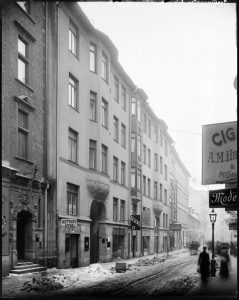
Östermalmsbiografen, Grevturegatan 20, unknown photographer, circa 1905-1920. Courtesy of the Stockholms Stadsmuseum/Stockholmskällan.
Considering how K. Hjalmar’s and Stina’s respective backgrounds are described in 1920 in Sveriges Film-och Biografmän,64Sveriges Film-och biografmän, 27. one might presume that at least in the beginning, Stina was more qualified to deal with accounts and figures than her husband. K. Hjalmar started his career as a mechanic before becoming a projectionist when he was twenty-five.65He studied at Tekniska Skolan in Stockholm, but the portrait does not specify which subjects or to what level. His wife, on the other hand, trained at a business school (Påhlmans Handelsinstitut) and worked in a book and music store before becoming a cinema cashier.
Filmbladet‘s 1918 article about Larsson-Acrel shares similarities to the description of Stina Lundblad, in that Larsson-Acrel’s good taste is also emphasized. The author points out that having bought the Bostock, Larsson-Acrel had to “paint and renovate and decorate and embellish” the venue while “at the same time, the programmes were selected with greater discrimination.”66“Film-och Biogubbar XXIV:Fröken Wilhelmina Larsson, Bostockbiografen, Stockholm,” 38. Both Larsson-Acrel in 1918 and Åman in 1916 refer to an earlier era of “bad” films, which they contrast with a contemporary, more sophisticated film culture. For example, Åman talks about competition from an ambulating exhibitor who showed much poorer film programs but attracted children by giving away sweets and lowering the price of tickets.67“Film- och biogubbar XV,” 149-150. And when Larsson-Acrel mentions the business she took over in 1914, she describes it as being “dragged down” by all sorts of inferior music and variety performances, but she claims that four years later, “…the cinema is something completely different. And the audience is also a different one.”68“Film-och Biogubbar XXIV:Fröken Wilhelmina Larsson, Bostockbiografen, Stockholm,” 37.
Taste and Music
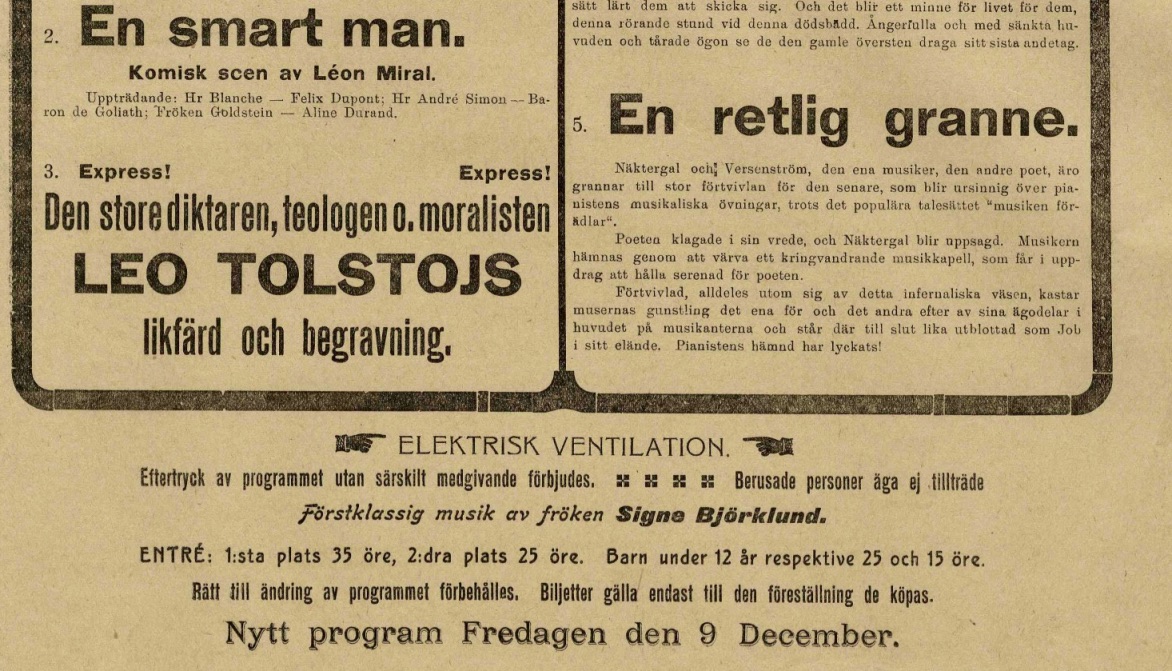
Detail from December 1910 program sheet from Eskilstuna-Biografen, promising “First class music by Miss Signe Björklund.”
Larsson-Acrel links bad taste to bad musical performances in the cinema. Piano-playing skills were an important component in middle-class female education in the early 20th century, and it is well known that many women worked as cinema musicians. Indeed film programs from Åman’s cinema in Eskilstuna in the years 1910-1913 advertise that the films are accompanied by “first class music by Miss Signe Björklund.”69Another example: when the Elite cinema in Stockholm wanted to recruit a pianist in 1910, they advertised in the “female” job section of the newspaper Dagens Nyheter and specified in the ad that they preferred a woman. See Dagens Nyheter (6 December 1910): 12. And just as women could advance from working in the cash register to managing the cinema, female musicians could also move on from accompanying programs to curating them, like the musician Ingeborg Sofia Emelia Krysell (née Kahl) who started her film-related career as a pianist at Visby Biografteater and later became director and musician at a rival cinema, Skandiabiografen.70Sveriges Film-och biografmän, 60.
To replace rowdy variety acts with respectable women pianists could help towards elevating the status of the cinema–or it could simply be a way to cut the costs. Regardless of whether the audiences attending the cinemas managed by Åman and Larsson-Acrel really did change or not, their statements belong within a teleological discourse of cinema culture as constantly improving, which serves the interest of the film industry. In this context, it is interesting to remind ourselves how women directors and screenwriters at a certain point in early American film production came to represent “propriety and uplift” in a much criticized business sector, and, in addition, how a discourse around taste, interior decoration, comfort, and politeness formed around women working in American cinema exhibition.71Lant, 561, 580. When it comes to the overall management of the cinema venue and the selection of film programs, some characteristics that at this time were associated with femininity seemed to be welcomed in Sweden in the 1910s, allowing Filmbladet to profile women cinema-owners as well suited for their jobs.
Conclusion
Fuller-Seeley and Ward Mahar suggest that the American film industry’s “concerns over outside censorship gave women influence in the business,” and state that some women film exhibitors “really did appear to be interested in cleansing the movies.”72Fuller-Seeley and Ward Mahar, n.p. It is difficult to determine to what extent the individuals whose work in film exhibition I have discussed in this essay were influential beyond the realm of their own cinemas, and how to describe for example Larsson-Acrel’s women-only screenings of a sex education film on “marital hygiene” within a context of taste and cleanliness. But considering that Sweden, unlike the United States, actually introduced state censorship in 1911, after years of debate in which female teachers, such as the censor Marie Louise Gagner were highly active,73Jernudd, 23. women can of course be seen to have shaped silent Swedish film culture in terms of influencing what was not to be screened.
In any case, like its American counterparts, it seems as though the trade journal Filmbladet championed women cinema-owners in the latter half of the teens. This was possibly part of a general drive to create a cleaner, nicer image of the cinema-going context. However, further research is needed into the work practices and curatorial choices of women cinema-owners in order to clarify the relationship between cinema culture and women’s rights and to map women’s access to opportunities in early film exhibition.74Archival paper collections used for this piece (all held at the Swedish Film Institute) are as follows: Sveriges Biografägareförbunds arkiv, Hjalmar Lundblads arkiv, Olle Waltås collection. Filmarkivforskning.se, an online resource, features many digitized cinema programs, journals, and magazines.
See also: “Exhibiting Women: Gender, Showmanship and the Professionalization of Film Exhibition in the United States, 1900-1930,” Anna Hofman-Uddgren, Marie Louise Gagner

